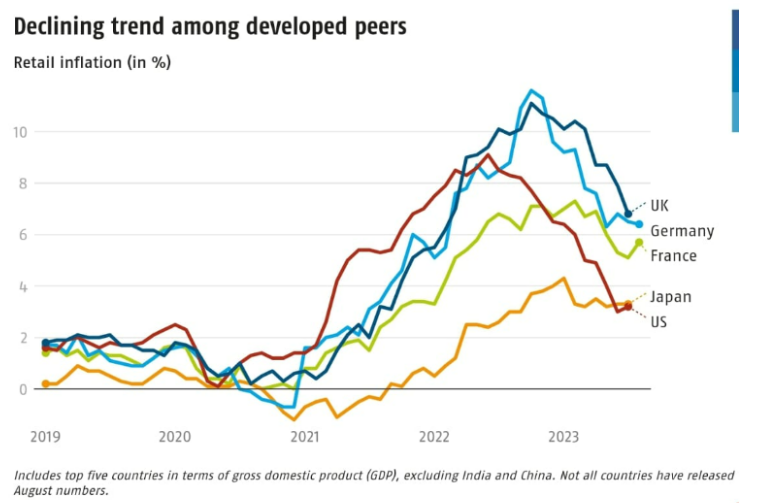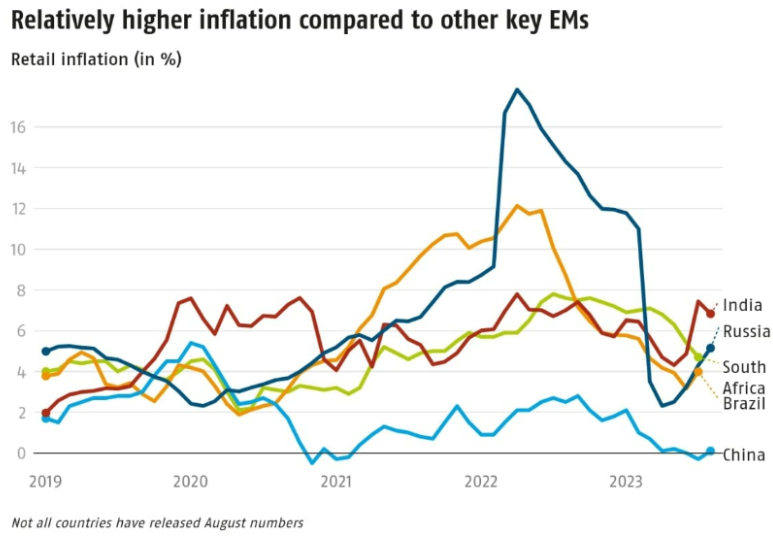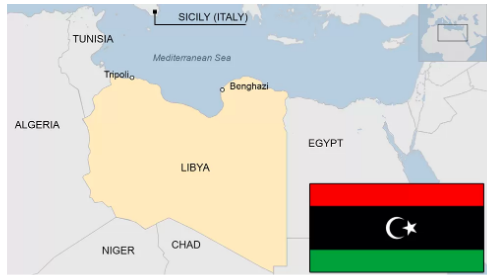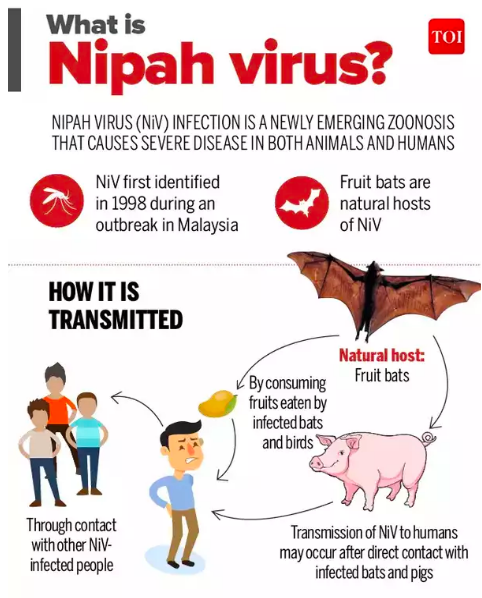India’s Inflation Higher than Peers
Context:
India’s peers among the largest economies in the world have broadly been seeing a declining trend in inflation in recent months.
Key Points:

- Global Inflation Trends: Germany, UK, and the US have seen declining inflation in recent months compared to the previous year.
- India’s Inflation Scenario: India’s inflation decline has been limited, aligning it closer to BRICS peers but with higher inflation rates.
- August saw India’s inflation dip to 6.83% from 7.44% in July due to monsoon disruptions and crop damage.
 Government Action: India responded to rising prices by reducing domestic liquefied petroleum gas prices and implementing export bans on food items.
Government Action: India responded to rising prices by reducing domestic liquefied petroleum gas prices and implementing export bans on food items.- Global Food Price Status: The UN’s Food and Agriculture Organisation reported a two-year low in global food prices in August.
- India’s rice export restrictions contributed to a 15-year high in the FAO’s rice index.
- Comparison with Peers: India’s inflation remains higher than top developed countries and its BRICS counterparts.
| Libya

|
Dams bursting during a storm caused severe damage to a quarter of Libya’s eastern city, Derna.
About Libya:
- Libya, a predominantly desert nation with significant oil reserves, gained independence in 1951.
- Geography and Population: Libya, situated in North Africa, primarily consists of the vast Sahara desert.
- The majority of its population resides along the coastal areas, where key cities like Tripoli and Benghazi are located.
- Libya is geographically defined by its boundaries:
- North: Bordered by the Mediterranean Sea.
- East: Shares a border with Egypt.
- South: Shares boundaries with Niger and Chad.
- West: Bordered by Tunisia and Algeria.
- Capital: Tripoli
- Language: Arabic
|
| Floodplain Loss

|
Researchers have created a comprehensive global dataset spanning 15 million square kilometers of floodplains across 520 major river basins from 1992 to 2019.
-
- A floodplain is “any land area susceptible to being inundated by floodwaters from any source”.
- This dataset is the first of its kind, quantifying human modifications in floodplains worldwide.
- Methodology: Used three geospatial datasets to track global floodplain extent, land use changes, and river basin boundaries for analysis.
Key Findings from the Study on Global Floodplain Alterations (1992-2019):
- Extent of Alterations: 460,000 sq km of floodplain converted for agriculture; 140,000 sq km redeveloped within existing floodplains.
- Continental Impact: Asia saw the largest loss (200,000 sq km), followed by South America (92,000 sq km) and Africa (73,000 sq km).
- Specific Cases: Amazon and Yangtze river basins experienced proportional increase in agriculture, leading to forest area reduction.
- Indian Subcontinent Focus: Irrawaddy (4.6%), Tapi (3%), Indus (3.2%), and Cauvery (2.7%) river basins noted significant floodplain alterations.
|
| Nipah Outbreak

|
Context:
The recent outbreak of the Nipah virus in Kerala has claimed several lives.
About Nipah Virus:
- It belongs to the family Paramyxoviridae, genus Henipavirus.
- Fatality Rate: The WHO estimates that between 40% and 75% of cases can result in death.
- Spread:
- It is a zoonotic virus, transmitted from animals to humans.
- Reservoir: The fruit bat, also known as the flying fox, serves as the animal host reservoir for the virus.
- Symptoms: Fever, headache, drowsiness, disorientation, mental confusion, coma, potential death.
- Presently, there are no vaccines available for both humans and animals. Intensive supportive care is given to humans infected by Nipah virus.
|
| Retail Inflation in India |
Retail inflation in India decreased from July’s 15-month high of 7.44% to 6.83% in August, primarily due to a decline in vegetable prices.
- However, the Consumer Price Index (CPI)-based inflation remained above the Reserve Bank of India’s (RBI) target range of 2-6%.
- CPI is a comprehensive measure used for estimation of price changes in a basket of goods and services representative of consumption expenditure in an economy is called consumer price index.
Food Inflation Decline:
- Food inflation, accounting for nearly half of the overall consumer price basket, dropped to 9.94% in August from 11.51% in July, according to data from the ministry of statistics and programme implementation (MoSPI).
- This was driven by lower vegetable prices, along with reduced costs in clothing, footwear, housing, and miscellaneous items.
- Key Factors: Within food items, vegetable inflation fell from 37.4% in July to 26.1% in August, contributing significantly to the decline in headline CPI inflation.
Core Inflation and Bond Markets:
- Core inflation remained at 4.8%, aligning with market expectations.
- The bond market may experience slight relief with a potential downward movement in yields, but the persistence and trajectory of inflation will determine broader market trends.
|
![]() 13 Sep 2023
13 Sep 2023

 Government Action: India responded to rising prices by reducing domestic liquefied petroleum gas prices and implementing export bans on food items.
Government Action: India responded to rising prices by reducing domestic liquefied petroleum gas prices and implementing export bans on food items.